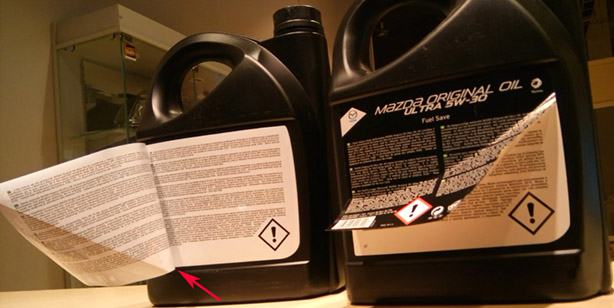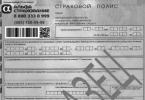Motor oil is one of the consumables, the quality of which directly affects the service life of the engine. Unfortunately, very often it is the lubricant that is counterfeited, and this applies to both various brands of lubricant and original oils. In this case, we’ll figure out how to distinguish fake Mazda oil. To do this, we will conduct a short review of oils for Mazda cars.
Before us are 3 canisters of different years of manufacture:
- Original Mazda Dexelia oil canister, purchased from an official dealer in 2017.
- A canister from previous years, purchased from an online store.
- And a liter canister purchased back in 2104.
From them you can understand how changes were made in order to protect against counterfeit products for Mazda engines. After all, oil in old-style canisters (2016 and later) is practically no longer found in the original - everything is fake, although it is worth noting that it is made of quite high quality (only with minor flaws). But over time, they will probably learn to make new canisters, so in 2018 or 2019 they will probably change something in order to even better protect the authenticity of Mazda motor oil. But at the moment it is worth paying attention to the quality of the canister, dates, barcodes, residue scale, and label quality.
Canister
For comparison, the first thing you need to pay attention to on a non-original canister is production of the container itself. She looks from below. We look at the oil bottling date, which is indicated at the bottom of the container. Coincides with the date of manufacture indicated on the canister itself, for example, the canister was made in April, and the oil was bottled in May (on the contrary, it would be illogical and it would be worth thinking about originality). When the date of manufacture of the canister and bottling differs by two years, then you also need to be vigilant; the original could have already changed its design in such a long time (no more than six months is allowed).
Label
Let's look at the label on the back of the canister. She should come off easily. In 2017, the manufacturer created new packaging for oils to avoid mass counterfeits. On canisters from previous years, the back sticker peels off from the right corner. The reverse side is all smooth, there is glue on the label along the edges, applied in dots. It doesn’t come off completely, it hangs on it. On new packages there is a corner, which you need to pull to peel off the label - left.
On a fake the whole label is sticky, like electrical tape, easily comes completely off the canister.
You need to pay attention to the lids. Recesses in the lids are an indicator of the original canister. In this case, the fake is made very well, and the plastic is of high quality. Although the porous structure of the plastic is visible and gives away a fake. On the original canister the plastic is smooth.
At the time of buying pay attention to the barcode. The last 4 solid lines are an indicator of originality.
You also need to pay attention to the signs. On new canisters, the oil level can be seen on the strip on the side of the lid. On all old canisters - on the opposite side. On a fake, this scale is not working at all (although it is supposedly present), the oil level is not visible.
Recently, the Moscow market has been flooded with counterfeits of original MAZDA oil.
They are sold both online and in large chain stores.
Below, we will describe several options for counterfeits that came into our hands. Each of them is different from the original, and each of them is different from the other, so most likely these are not all possible options.
All of them are united only by the poor quality of the plastic canisters and sloppy labels.
In the first photo, the real canister is on the left. There are visible differences in the font of the batch number and production date (on the fake, almost nothing is visible, you can only make out 09/15). Lack of halftones in the print of green waves, and in the inscription “ZOOM-ZOOM”. In the original, the inscription changes from different viewing angles, but on the fake there is no this effect, and the letters are much brighter.
In the second photo the real canister is on the right. There are two fakes in the center and on the left. Arrows indicate differences.

Due to friction against the box, the fake label was erased. This doesn't happen with the original.

The two fakes have the same batch numbers and the same production day in different fonts.



On the fourth fake, practically nothing is visible, except for September 2015.

This is what the actual markings on the 2015 model canister look like.


15 year marking on the bottom of the fake canister.

The width of the measuring scale on this canister, marked “15”, is from the 2013 model.
The 2015 canister is on the left and has a wide scale on it.

However, there are fakes with a wide scale. The real canister is on the right, in the center and on the left are two fakes. One has a narrow scale, the other a wide one.

Fake plastic quality.
Traces from a roughly processed plastic mold are visible.


Fake plastic.

A real canister.

Debris is clearly visible under the counterfeit label. It is present in greater or lesser quantities in all samples. Apparently production takes place in very dusty rooms.

The canister has a pronounced relief from the casting mold in the neck area. On the original it is barely noticeable. Garbage under the label is indicated by arrows.

The counterfeit plug is not recessed, like on the original, oil flows from under it.
However, most fakes now have a recessed cork like the original.

Liter canisters. Quality of plastic and ZOOM-ZOOM.
Fake on the left.

The font on the back label of a real canister from 2014.

The fake font, closer to the lower right corner, is completely blurry.

Two fonts side by side.

The fake has a narrow scale.

Quality of plastic. The original is in the foreground.

Fake on the left. The quality of the plastic and the difference in marking fonts.


Stickers from large chain stores on fakes.



A characteristic feature on all fakes is smoothed corners.




On a real canister, the corners are clearly made.

Second label on the back wall.
It is almost impossible to peel it off from a real canister. The first label comes off easily, but the second one can be torn off only after severely damaging it.


From fakes, the labels come off together, and you need to try very hard to separate them later.


One of the fake canisters is a centimeter higher than the original one. The corners are poorly executed.

Another fake is lower, it is completely missing part of the neck, under the cork. The original canister stands nearby, the differences are shown by arrows.

Let's take a closer look at the front labels.
“Broken” pixels in the inscription ZOOM-ZOOM on a fake.

The letters overlap each other. The edges of the letters are fuzzy.

Another variant.

Here the letters in different lines have merged into one whole, and the spelling of the letter “a” is different.

Everything on the original canister is printed clearly.

This is not a complete gallery, it will be updated.
Be careful.
It's time to add new designs to our collection.
The first sample was made very clumsily, at the level of fakes made three years ago, despite the fact that it was purchased in an online store in 2016.

The cork has no indentation, poor plastic with unclear corners, the green label is half the size of the original.

The original is on the left.

The quality of label printing requires no comment; the production date and batch number are simply missing.
Bad plastic, unclear corners

A new element has appeared - a certain triangle, missing from the original can.

Sample number two. Purchased from Exist.
The canister is made worse, the labels are much better than the first sample.
An exclamation mark appeared on the back label, which had never been seen on fakes before.
There is a triangle behind the stopper, as on the first canister, a pronounced imprint of the shape above the label.

The batch number is printed in a different font

Here is the original font

Fuzzy corners, triangle behind the plug

On the left is a fake, on the right is the original. The fake has smoothed corners and the canister is slightly lower.

Sample number three. Also Exist.
The exclamation point is in place, the label is printed quite well.

The batch number is printed in a completely different font, different from both sample number two and the original.


Part of the neck is missing under the plug. The canister is lower than the original, and the common feature of all samples is smoothed corners and porous plastic.


Exist sticker, bad plastic.

On the last two samples, the back labels look similar, the second label is smaller than the first, like on the original, a slightly uneven curve.
On the original, the first label is glued to the second using small adhesive dots, shown by the arrows on the original canister (it's on the left). The labels themselves do not have an adhesive layer and are dry to the touch.
Fake labels are smeared with a continuous layer of glue; they feel like electrical tape and stick to your fingers.

On the original canister, the first label peels off from the second from right to left, and when it reaches the edge, it does not come off any further, the left edge is glued very tightly, like the binding of a book. On the fake (on the right), the label comes off randomly and is not held in place by anything.

We will cover new samples as they appear.
Good day to all! After reading this article, you will learn how to recognize fake Mazda oil using the example of the Mazda Original Oil Ultra 5W30 product.
What made me write this article? Yesterday, at the end of the working day, a client from another city came to our office to buy original Mazda oil. His warranty service had expired and he had to change the engine oil himself. He took the choice of oil very seriously. This was indicated by the presence of instructions from the Internet, printed on several sheets of paper. We checked our oil canister according to his instructions and came to the conclusion that our oil was real. Today I decided to make such instructions myself. I contacted oil suppliers, found out everything and summarized everything in this material.
Fake Mazda oil - external distinctive features
To avoid running into counterfeit Mazda oil, you must take the product only from verified places. You need to choose oil based on the recommendations of friends or based on your own experience. But what to do if none of the above exists? Then our instructions will help you, with the help of which you can easily distinguish original Mazda oil from a fake. So let's get started.
.jpg)
First of all, you need to take the canister in your hands and carefully examine it. First of all, inspect the cover. It should have a depression and a small convex point in the center. If the lid is not like that, then feel free to refuse the oil - this is an outright fake.
.jpg)
The next step is to evaluate the print quality. There are a lot of halftones on the original label. This gives a very strong indication of a fake. The pirates were never able to achieve high-quality printing. On the original canister the inscription ZOOM-ZOOM is barely noticeable. But with fake oil it is very noticeable. The situation is similar with the spots in the upper left corner. All contrast transitions from white to black are not clear. This is due to the fact that the original image before printing was vector. And the fake Mazda oil most likely used a scan. Here's another significant difference.
.jpg)
Let's move on. Now you need to inspect the back of the canister. In addition to the print quality, pay attention to the bottom backing of the label. The fact is that the back label of the oil consists of two layers. On the original, the top layer of the back label comes off easily. For a fake, it takes some effort, but paint remains on the white background.
.jpg)
These are the three main signs by which you can easily distinguish real Mazda oil from a fake. Now let's look at a few more small distinguishing features.
Relief line. On the fake canister there is a strongly convex raised line, while on the original it is less noticeable.

There are codes on the back of the fake oil, but there shouldn’t be any on the original.

The embossing on the bottom of the cans is very different:

In addition to these signs, you should pay attention to the barcode. Several cases have been recorded where the fake was absolutely no different from the original. Fake Mazda oil was only identified by a barcode. The pirates mistakenly missed one bold line between the numbers 5 and 0
.jpg)
This is how it should be:

How to distinguish counterfeit Mazda oil by the external signs of the oil itself?
There are also a couple of distinctive features of the liquid itself, which is poured into canisters. Firstly, real Mazda oil Original Ultra is a translucent light pink color. The fake is very different:
.jpg)
Secondly, fake Mazda oil has a pungent smell, but the original does not.
And at the very end of the article I would like to note that the oils themselves are not counterfeited. As a rule, the original canisters simply contain cheaper oil. This oil will not break the engine, but who wants to be deceived? After inspecting the canister, pay attention to possible defects. It is important to pay attention to signs of an autopsy. You may have an original canister in your hands, but there will be a different oil inside. That's all, I hope this material will be useful to you and you can easily distinguish fake Mazda oil from fake. Don't forget that we have several other topical articles on our website that are worth checking out.
Official information has appeared from the Mazda Ukraine representative office about counterfeit Mazda Original Oil motor oil.
Fake motor oil has become widely available in Ukraine. The level of execution of the fake is quite good. The packaging design is very similar to the original motor oil.
What is inside?
The original motor oil is intended for filling into Mazda car engines, developed with the participation of the company's designers and ensures optimal lubricating properties of parts throughout the entire service interval. Having carried out a chemical analysis fake oil Mazda Original Oil, experts came to the conclusion that it does not meet even the minimum standards that the modern automotive industry requires for oils of this level. The fake is mineral motor oil of the lowest quality! Oils of this level are characterized by extremely low stability of their characteristics and a high degree of volatility. In the case of using such motor oil in modern engines, it leads to accelerated wear of friction parts, the formation of slag, carbon deposits and other difficult-to-soluble deposits. This significantly reduces the life of your car's engine and increases the likelihood of its failure.
Below are the main differences between the original oil canister, which produced by TOTAL, and packages with counterfeit motor oil.
A fake can of oil can be identified by a number of signs that are visible upon detailed inspection.
On a counterfeit can, the date and batch number are missing or marked in such a way that it is impossible to identify the product. On the original can of oil, all the designations are applied in black or green computer print, where they are clearly marked:
- Manufacturer's plant and product code;
- Engine oil production date;
- Batch number.
Fig. 1 On the left is the original oil, and on the right is a fake.
In addition, there is a noticeable difference in the quality of the label images. The image of a fake label (in Fig. 1 on the right) was printed from a scanned original label (and not from the original layout source prepared by the designers). This significantly affected the quality of the printed label of the fake oil:
- Fuzzy color transfer print on the fake canister.
- The wave color shimmer in the upper left corner of the counterfeit label is darkened and not fully displayed as on the original label. (Fig.1.)

Fig.2 On the fake label, the letters ZOOM-ZOOM are blurry and unclearly printed
Due to the reasons stated above, the slogan ZOOM-ZOOM on the label of fake oil is not very clearly depicted and has less contrast against the background of the black label. The letters are not monochromatic - spotted dark areas are noticeable, and the letters also have uneven, “torn” edges. On the original label, all the letters are even and monochromatic - without spots or color tints.
On the back of the canister, there is a noticeable difference in the text and graphic elements. For example, there is no "exclamation mark" marking in the diamond. In addition, the shape of the back label is different: the lower white sticker, which is located under the upper black front sticker, on the fake one repeats the almost square shape of the upper black label. In the original, the white label has a noticeably rounded lower right corner.

Fig.3 On the left is the original oil, on the right is a fake in which the bottom label is made in the shape of the top one.
Also pay attention to the quality of the plastic of the fake canister. So the fake uses low-quality plastic, as well as a mold for casting. As a result, fuzzy casting lines and increased porosity of the material visible to the naked eye are noticeable. In Figure 4 you can clearly see the difference in impressions when casting a fake canister.

Fig.4 On the left is the original oil, on the right is the fake.
A characteristic feature of fake oil is also the plug. It is universal and smooth on a fake canister. On the original oil can, the plug has a noticeable indentation in the central part.

Fig.5 On the left is the original canister and stopper, on the right is the fake.

Fig.6 On the left is the original canister and stopper, on the right is the fake.
The differences are also noticeable at the bottom of the fake canister. There is a noticeable difference in the date of manufacture of the canister. Like most counterfeit canisters, to make the process cheaper, it is made using a separate imprint with an arrow that indicates the production date. During the production process, craftsmen move this hand to whatever date they need to print. Such additional, separate application of plastic on the production date is strictly prohibited in the legal industrial production of plastic containers. On the original canister, such a production imprint is made clearly in a single mold for casting the canister, without additional applications or seals.

Fig.7 On the left is the original canister and stopper, on the right is the fake.

Fig8. Production date stamp on a fake canister.

Fig.9 Stamp of the production date on the original canister.
Be vigilant. Do not buy products from dubious points of sale. And check the product during purchase!
What kind of oil should I put in the engine?- a fairly common question. Everyone knows about the importance of timely oil changes and, of course, everyone wants to fill the engine of their car with the best oil.
Unfortunately, there is no clear answer to this question:
- You can find a huge number of discussions on the topic “what oil to put in the engine”
- You can watch a bunch of videos with all kinds of motor oil tests
- You can re-read a huge number of articles on the topic of engine oil
But nowhere will you get a definite answer as to which oil is the best. And let’s say more, the more you delve into this topic, the more contradictions you will find and the more difficult the choice becomes.
What to do in such a situation?
First of all, refer to the manufacturer's recommendations. Open your car's owner's manual and see what it says. But everything is simple there, or owners of Mazda cars are relatively lucky, since Mazda does not offer many options for choosing oil for their cars:
MAZDA ORIGINAL OIL ULTRA 5W-30
old hydrocracked oil, according to SM specification
- recommended for all Mazda gasoline engines, including SKYACTV
MAZDA ORIGINAL OIL SUPRA 0W-20
Latest SN specification oil
-recommended and developed specifically for SKYACTIV engines
But this does not mean at all that you need to use strictly only original Mazda oil. Moreover, Mazda itself does not produce and has never produced automobile oils. It is also a well-known fact that original oils for Mazda are made Total- for the European market and IDEMITSU for the American market.
You can choose oil for your car from any manufacturer, the main thing here is to adhere to the specifications recommended by the manufacturer
- for SKYACTV engines - we recommend using oil with a viscosity of 0W20 according to the SN specification
- for all other engines, except SKYACTV, 5w30 oils according to the SM or SN specification are excellent
- for our clients we always keep in stock oils of the required viscosity and specifications of the following brands: MAZDA ORIGINAL,Total,IDEMITSU, MOTUL
Another important point! - beware of fakes!!!
Recently, a lot of counterfeit automobile oils have appeared on our market. Therefore, beware of buying car oil in unverified places and at temptingly cheap prices.
Unfortunately, we cannot give clear recommendations on how to distinguish fake oil from the real thing. The fact is that the degree of protection of the original oil is not too high. Or it’s not difficult to fake quality packaging. But you will not be able to determine what is poured inside the canister.
For our part, we GUARANTEE that all oils that our car service offers are purchased from official distributors and are not counterfeit.



